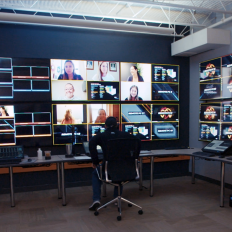What It Means For Your Event.
It’s late Q4 and time for the traditional round of year-end recaps, listicles, and reports. Particularly interesting in this year’s round-up is identifying what trends have emerged in virtual events. Two of our virtual platform partners, Bizzabo and Intrado, have published data from events hosted on their platforms this year. They highlight both how planners have approached events this year and how attendees are consuming information. Audience engagement data must dictate your plans for 2021. Overall, audience engagement has grown this year in key areas.
Questions asked during webcasts rose by 278%.
This was interesting since webcasts are not new. What has changed is the audience’s comfort with interactivity. Perhaps it was the total immersion into virtual engagement that flipped the switch. And now that they realize they can, they will expect to have a dialogue.
While that kind of engagement is a huge win overall, it does raise questions of its own. Does that mean every presentation has to be delivered live? Nope. Many of our clients pre-record their presentations and then open a live Q&A. It’s called simu-live and gives you the best of both worlds – the quality control of recorded with the authenticity of real-time responses.
On-demand content view rates have more than doubled.
Interesting! That says two things to us (which are validated by our client experiences). First, a compelling virtual event will drive attendees to explore more. Second, audiences like the flexibility to consume content at their own pace. This is a tremendous trend to capitalize upon. For example, that on-demand content can be a source of on-going communication. You can place brand messages on the content site, provide updates on refreshed or new information, and begin to create a community around the information you provide.
Most event marketers still struggle to drive value for sponsors and yet virtual event booth visits increased dramatically.
Classic good news/ bad news. There are more people in the booths but it appears that sponsors are not capturing the value of those visits. The problem may be in the booth experience – how easy it is to navigate – and how compelling the content is. There are steps event owners can do to choose the most robust platform and help sponsors make the most of its features. They can also do more to “prime the pump” for sponsors by launching in a dynamic content marketing campaign around the event that spotlights sponsors and drives engagement.
Weekend events are on the rise.
With so many people working remotely, it was inevitable that the home/work line would continue to blur. So Saturday and Sunday have become fair game for events. However, there is still a certain aura around the weekend. If someone is going to devote free time to the event, the pressure to deliver is higher. The takeaway is that a weekend event should be snappy, intriguing, and snackable. The broadcast should also be optimized for mobile, as it is more likely it will be viewed on a phone. Additionally, on-demand content is important as the audience may not stay for a lengthy live program.
These staggering statistics prove that audiences are looking to engage content in new ways complicating the event planning and execution. Although the research also showed,
The majority of virtual organizers have yet to partner with a production services company.
This was a surprise. That means a lot of companies have taken a boatload of work upon themselves and at what cost? The bar on virtual events rose fast over the past year. The Zoom novelty wore off and audiences are expecting higher quality, more value, and more bang for their attention, if not their buck. Companies that would not have attempted to mount an important live event without production help may have been lulled by the deceptively accessible nature of virtual meetings.
In order to accommodate the expectations of large audiences, including networking, interactivity, multi-media content, on-demand content, and broadcast quality, more sophisticated platforms and production are critical. Virtual events may seem easier than in-person events, but from a production aspect, it involves creating three experiences in one – broadcast, web, and engagement.
So to all those virtual organizers out there – you don’t have to go it alone. Partnering with virtual event experts (like Cramer) doesn’t just make things easier, it raises the quality of the program and will improve your audience’s engagement, as the data shows.
Go ahead and check out the report. Stats are always interesting. More importantly, they can spark new ideas and conversations. In fact, we’d love to start a conversation around this with you. Let us know what you found intriguing and how data may inform your plans for 2021.



